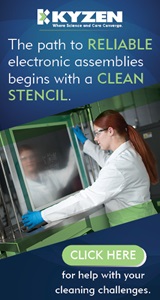| Ask the Experts |
|
|
April 13, 2011 - Updated
April 11, 2011 - Originally Posted
Soldering Iron Tip Breakdown
We are having a problem with soldering tips oxidizing and becoming unusable after a few hours use.
We are using a lead-free organic rosin core solder and we usually apply additional liquid rosin flux when soldering fine pitch components. We are running the soldering irons between 750 and 800 F.
Our soldering iron manufacturer suggests re-tinning the tips every 3 joints.
Is there anything in the metals in lead-free solder that would cause the tips to oxidize or de-plate so quickly? We never had tips breakdown so rapidly with leaded solder.
S. O.
|
| Expert Panel Responses |
This is a great question and a real problem being experienced by many users of lead-free solders.
With the introduction of the lead-free solders the thought process was to increase the temperature of the tools and equipment being used for soldering as the liquidus temperature of the new alloy was quite higher than the melting temperature of the good old 63/37 or 60/40 Tin/lead alloy solder. We were wrong, increasing the solder iron temperature did not help in fact it created more problems and tip usage went through the roof.
We are soldering lead free materials between 600 and 700 degrees F and increasing the contact dwell time by about 1 to 1.5 seconds. The new lead free alloys are high in Tin content and the tin will dissolve the plating on the solder iron tip and eventually eat through the tip. Yes you must keep the tip tinned.
Additionally there is some concern also with the sponges being used to wipe the tips as this creates too much of a thermal shock on the tip and results in cracking the plating on the tip.
When the plating cracks on the tip, the Tin will dissolve the copper relatively quickly; so many people are now using the metal brillow type of pad which comes with many irons today to clean their tips. Using these pads will not cause any shock to the solder iron tip and should help in increasing the tip life.
Regardless of what the tip life was when using Tin/Lead solders, the life of the tips will be shorten drastically with the use of Lead-Free solder alloys.
Leo Lambert
Vice President, Technical Director
EPTAC Corporation
At EPTAC Corporation, Mr. Lambert oversees content of course offerings, IPC Certification programs and provides customers with expert consultation in electronics manufacturing, including RoHS/WEEE and lead free issues. Leo is also the IPC General Chairman for the Assembly/Joining Process Committee.
|
|
Submit A Comment
|
Comments are reviewed prior to posting. You must include your full name to have your comments posted. We will not post your email address.
|
Free Newsletter Subscription
Circuitnet is built for professionals who bear the responsibility of looking ahead, imagining the future, and preparing for it.
Insert Your Email Address
|
|





